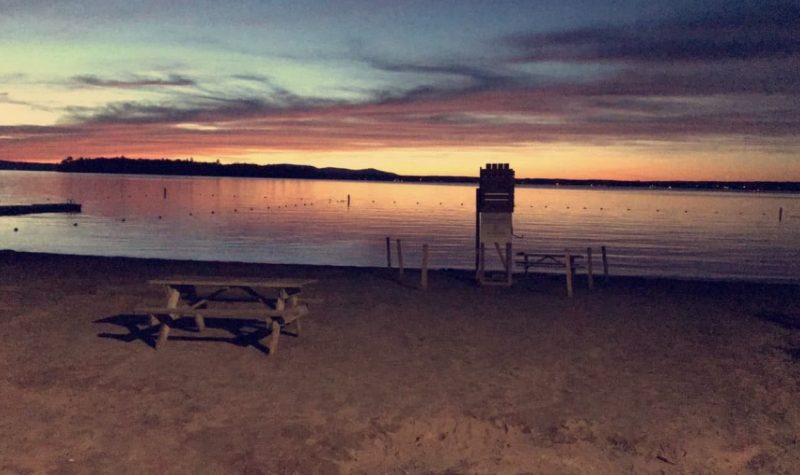Conservation Lac-Brome recently received funding from the Town of Brome Lake and the Ministry of Environment to launch its “Blue Patrol” project this summer with the goal of helping citizens and visitors adopt responsible behaviours to improve the quality of the water in Brome Lake and its ecosystems.
“Three students will knock on doors of citizens to give tools on water runoff management. These tools include having plants on the shoreline, they will explain to citizens how they can vegetate their shoreline, how they should manage their gutters, and what to do with the water that is on their property. (…) We want the water to be filtered by plants,” explained Renaud. “We encourage citizens and visitors to ask questions to the patrollers and they will be pleased to inform you about eco-responsible practices.”
The results of Conservation Lac-Brome’s water sampling project, which was conducted last year, raises concerns for the group due to the amount of sediments found at the bottom of Brome Lake and it is encouraging citizens and visitors to develop eco-responsible practices while in and around the lake.
Conservation Lac-Brome presented the results of its water sampling project at its 2023 Annual General Meeting at the beginning of May, which studied the thickness of the sediments found at the bottom of Brome Lake and the nutrients found in these sediments. It is the first study to be conducted since 2006. What stood out from the results of these water samples was the amount of phosphorus found within these sediments, which can contribute to the growth of cyanobacteria.
While the amount of phosphorus going into the lake from the watershed has been more under control over the last 20 years, the concern is the sediments that have accumulated at the bottom of the lake being brought up to the surface and the effects it will have on its health, according to Don Joyce, member of the board of directors for Conservation Lac-Brome. As a result, the group is asking Brome Lake residents and visitors to the area to play their part by remaining cautious of the impacts that their activities can have on the lake.
“We observed that there was a correlation between the quantity of phosphorus in the sediments and the thickness of the sediments. When there was more sediments, there was more phosphorus in it. They mostly accumulate where the current is really slow, so it’s mostly in deeper areas where it’s more than three meters deep,” explained Anaïs Renaud, biologist and project manager for Conservation Lac-Brome. “The other thing that we observed was that in 2022, the level of the phosphorus exceeded the critical threshold in more than half of the samples. (…) The phosphorus in the sediments was 2.5 times more significant than in 2006 in some areas of the lake and it was more in the shallow areas.”
According to Renaud, the study “tell us that the lake is still vulnerable,” despite the efforts of Conservation Lac-Brome, volunteers, and residents over the years to ensure the water quality of Brome Lake. She noted that phosphorus can come from streams, boats, and the shoreline.
“There are lots of activities around the lake, lots of residents, a lot of boats going on the lake. We should be very cautious about what we do on the lake and around the lake because our activities have a great impact and these impacts can be seen quickly,” said Renaud. “For example, when we have big showers during the summer it’s after these showers that we can see lots of blue green algae coming up. That tells us that there’s lots of phosphorus coming from the shorelines that is brought into the lake by water runoff.”
“I think what we’re seeing is that we got some stability with the phosphorus coming in from the watershed, that’s good news, but the foot-side of that is that we still have a lot of phosphorus at the bottom of the lake. We’re concerned about churn in the water bringing that back up,” mentioned Joyce.
Joyce added that phosphorus feeds the blue green algae and forms “a pea soup” at the top of the lake, which can be toxic to humans and animals. The group’s immediate concern is the growing popularity of the wake and wave boats, according to Joyce.
“They displace a lot of water and if they’re not out in the middle of the lake where there’s five, six, seven meters of water underneath they can churn up the phosphorus that is in the sediments,” he explained.
Joyce and Renaud both emphasized that citizens and visitors need to play their part to help alleviate this pressure on the lake and to limit the amount of sediments going into the water to avoid further accumulation.
“The town has put out an excellent map that shows where you should use wake and wave boats. If people can restrict themselves to that area, that will do a lot to help make sure that we don’t churn up the bottom,” Joyce highlighted.
“Everyone should manage their runoff on their property and avoid fertilizers, that’s something really important. Boaters should have eco-responsible practices, like navigating in deeper water and avoid following the shoreline,” mentioned Renaud. “That’s two good practices."
Listen to the full interview below:


